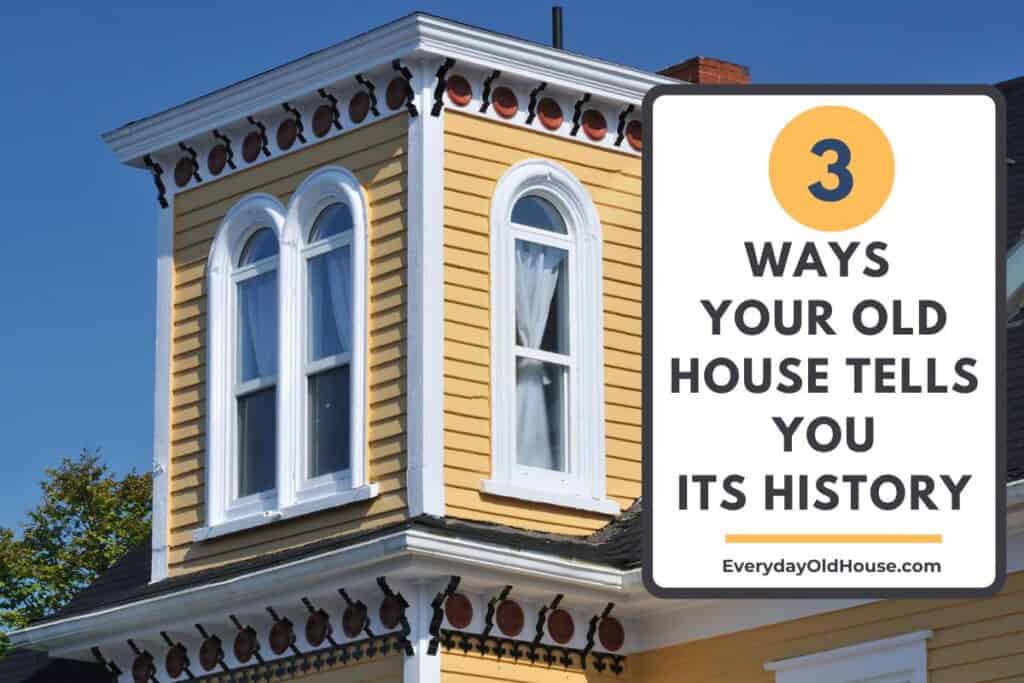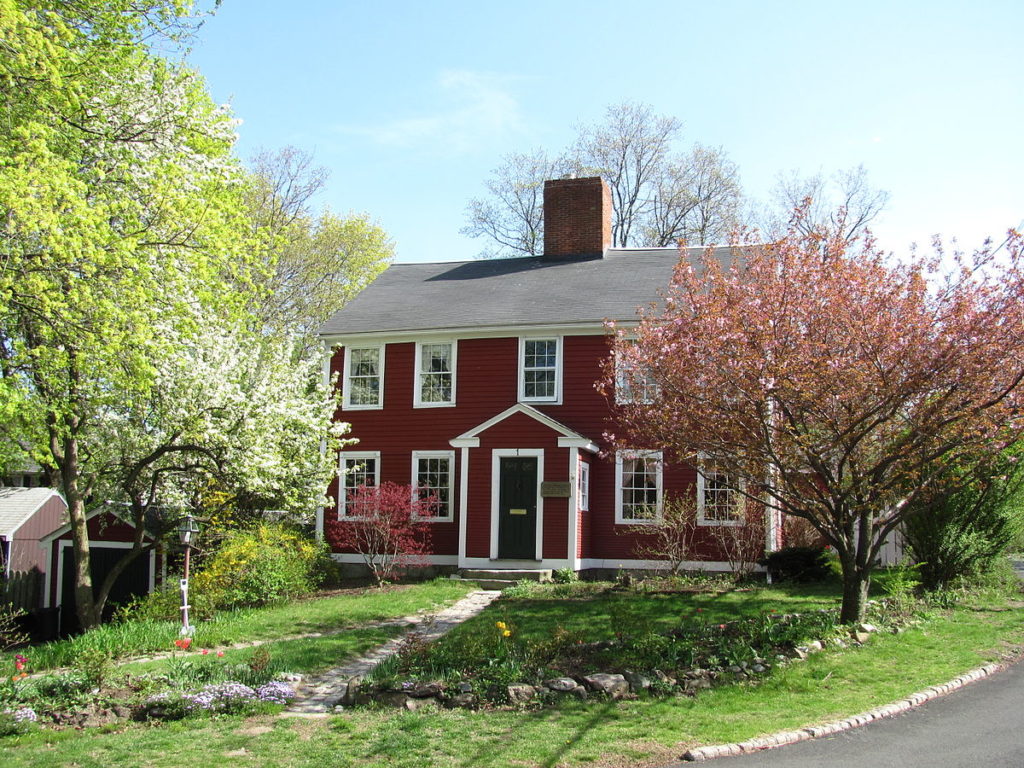Last Updated on March 20, 2024
Interested in researching your home’s history? Wonder when it was built and who used to live there? Curious if you can discover your home’s story just by looking at it? Yes you can! Here’s 3 major visual clues to tell how old your house is just by looking at it.

BEGINNER’S GUIDE TO HOME HISTORY RESEARCH
Interested in researching the history of your old house but unsure where to start? Grab my newly-release:
Beginner’s Guide: How to Trace the History of Your Old House
This 60-page guide takes you step-by-step through 25+ online and in-person resources to create a picture of your home’s history.

Visual Clues to Your Home’s History
As mentioned in the Beginner’s Guide, researching the history of your house consists of following these 3 “trails”:
- Paper trail (i.e. deeds, newspapers)
- People trail (i.e. neighbors, previous owners)
- Visible Trail (i.e. the house itself)
The paper trail uncovered your home’s facts, such as historical maps, photos, and deeds. The people trail shaped a charming story about the people who lived and died in your home.
Next, let’s look at your house and the surrounding area for visual clues. All it takes is merely opening your eyes and walking around your property for it to tell you its history.
Admittedly, this part of my house’s research wasn’t as easy as the paper or people trails. Finding visual clues can be very subjective. It’s easy to miss something or make a mistake. However, I found the exercise of finding visual clues supported the other two trails to create a more cohesive house history.
In other words, while some home’s visual clues are subtle and left to the experts, an amateur with a sharp eye and a little bit of knowledge can tell how old your house is by looking at it.
Where Do Find Visible Clues to Your Home’s History?
There are various ways to research the history of your home – deed or census search, talking to neighbors. But have you stopped and looked for clues around your house? Here’s how you do it….
There are 3 places you should examine to find visible clues to tell how old your house is.
- Neighborhood
- Home’s Exterior
- Home’s Interior
Let’s dive in, shall we?
1. Neighborhood
One of the best ways to learn about your home is to first discover the history of your neighborhood.
Compare your property to the properties around you for visual clues to tell how old house is. So, how do you do that?
First ask yourself, where is your neighborhood in comparison to the city or town center? While not definitive, older homes tend to be closer to the center of town. (A major exception being farmhouses). But in general, over the years, town grew out from town centers with more recent developments at the outer edges.
Next, ask yourself the question – where does your house fit in relation to the rest of your particular neighborhood? Here’s a few visual clues…
Proximity to Road
Where is your home in comparison to the road and the neighboring houses? Is the house situated differently than the neighboring houses? Is your house uncomfortably closer to the road?
If so, the house may pre-date a more modern road. You can likely get the age of the road through local historical maps.
Front Door Placement
Does your front door not face the street? Like proximity of your house to the road, a front door placement that is at an angle, or just seems “off” may be a clue that your home is older.
Neighboring Homes
Does your neighborhood comprise a mixture of younger and older houses? Or do the neighboring houses look remarkably similar in style and age? If so, your neighborhood could have been part of subdivision (i.e. large acreage of land divided unto sublots and then developed by the same builder within a short period of time)?
Oldest House
If you live in the suburbs, there’s a good chance that your house was previously part of a larger farm. And the original farmhouse might still be standing.
Look around for a house that looks older and doesn’t seem to match the style of the others. A bit of a “one of these things is not like the other” exercise. And it’s likely the old farmhouse.
For my home history, I was able to determine (through the use of maps) that my house was once part of farm. And the original farmhouse (shown below) pre-dates 1750 and still stands at the top of my street.

2. House Exterior
Every home’s exterior has as a discernible architectural style – or a combination of two. Distinct architectural styles were popular during particular era of US history – for example, Victorian (1860-1900), Craftsman (1900-1930) and Mid-Century Modern (1945-1980s).
Luckily, for most homes, you don’t need to be an experienced architect to determine the prominent style of your house. Just grab an architectural guide on American domestic architecture. Here’s my favorites:
- A Field Guide to American Houses – one of my fav old house books!
- Guide to Old House Styles and Architecture on Old Houses.com
- National Association of Realtor’s Guide to Residential Styles
These guides will help you carefully look and evaluate your home’s components so that you can identify its architecture, asking questions like:
- Overall shape of the house (i.e. square? symmetrical?)
- Type of materials used in construction (wood? stone? stucco?)
- Roof characteristics (i.e. gabled? hipped? flat?)
- Extent of decoration (i.e. uncomplicated or detailed?)
- Window placement and style
Admittedly, if your older house has undergone several renovations, you may start scratching your head. You might find out that largest part of your home is not original, but rather an addition. Or that additions were not sympathetic to the original style of the house and now you have a confusing jumble of architectural periods.
But this situation creates a story in itself, right? These additions reflect the cumulative changes of past owners.
Don’t Stick to Just the House….
Looking for visual clues goes beyond just evaluating the structures. The rest of your property or yard can also provide clues.
Keep an eye out for various artifacts while landscaping – dishes, soda bottles, coins, etc. If feeling adventurous, you could rent a metal detector.
If feeling adventurous and think your house pre-dates interior plumbing, you could try to find and examine the contents of the old privy hole.
On second thought, I’d rather not…. ?
3. House Interior
In addition to your home’s exterior, visual clues on the inside of your house can provide a sense of past characteristic of your home, including renovations.
Here’s a few examples of what to look for to gain a sense of your home’s history.
Windows & Doors
See if you can compare the style of molding around your window and doors in the residential architectural guides noted above. Door and window hardware, such as glass doorknobs, can hint at when your home was constructed or upgraded.
Walls
Do your walls consist of plaster or drywall? If plaster, that is a good indication that your home was built before 1916. Drywall was invented in 1916 but wasn’t widely used until the 1950s. Walls made with drywall indicates a modern home or renovation.
Don’t forget to look at all your walls. If you have an older house, you might have a combination of plaster (original walls) and drywalls (renovation).
Foundation Beams
Examine the beams in the basement and attic. They may show marks of a broadaxe or tooth saw (i.e. pre-power tool) versus the modern circular saw.
Also check to see if the beams held in place by wooden pegs, hand-made nails, or machine-made nails. (If so, your house is OLD!)
Nooks and Crannies
Look between walls, under floorboards, attic rafters, back of closets and other hard-to-find areas (basement, fireplace). House-specific information such as architectural plans, kit house instruction manuals, or owner-specific information like journals could have been stuffed in the corner of a closet, or attic and forgotten. Newspapers were often used as insulation between walls, which could provide a construction or renovation year.
We found this old Snoopy notebook hidden under a stairtread (when fixing the attic stairs). Using our local town’s Facebook Group, we actually connected with the girl-now-woman who wrote this. She told us a bit about her family that lived in our home in the 1980s.
Utilities
A lot of utility equipment are labeled with installation dates. Check your fuse box, furnace, and meters for dates of installation or equipment manufacture or maintenance.
Toilets often have a date stamped inside the tank on the back wall or bottom of tank lid. We were able to confirm that the random toilet in our basement wasn’t installed for the original builder since the toilet was stamped 1931, which is 15-20 after our home’s construction date.
Autographs
Reportedly, contractors, especially plasterers, commonly signed and dated their work. And previous homeowners (and their children) also like to leave notes to future owners. Be sure to check less visible areas or areas that aren’t commonly renovated – such as back or closets or unfinished basement walls – for signatures or notes.
Extra Tips for Determining Your Home’s Age
To wrap up here’s a few tips while searching for visual clues to tell how old your house is.
Look Closely
Take your time and carefully scan each of the walls outside and inside your home. Start from the bottom and work your way up. Look at the brick or stonework in the foundation and basement. See any differences? Bricks of two different sizes? Different color masonry? This could be evidence of a renovation, addition, or even a rebuild after fire or flood damage.
Basement
If your basement looks newer than the rest of the house, your house may have been physically moved from a different location. It wasn’t uncommon to move a house due to it being in the ways of expansion of public infrastructure (i.e. utilities, roads) or industry (i.e. expansion of manufacturing plant).
My childhood home was originally located on a main street and was moved in the 1980s to convert the area from residential to commercial.
[Curious how a house gets moved? Click here and then scroll to the bottom.]
Paint Colors
To determine previous exterior house paint colors, look underneath windowsills, or behind the meter box, doorbell plate, and mailbox. For interior paint color (or wallpaper), look under windowsills, in closets, behind the cast iron radiator and electrical sockets and lamp sconces.
Check out the multiple layers of colors this homeowner found when he removed the doorbell on the door on his Queen Anne Victorian in Northport, NY!

Related Posts
Disclaimer
I am not a professional home genealogist (nor play one on tv….). However, as a environmental consultant for 10+ years, I researched the history of 100+ commercial properties for property owners, potential buyers, and real estate developers. I utilized a variety of historical databases and resources – historical maps, government databases, interviews, and property visual clues – to create a picture of a property’s past.
My mission is to use these consulting skills (combined with genealogy classes) to help other homeowners to research the history of houses.
Note that my experience is limited to the United States. For European homes, I suggest this website.
Want to be the first to know about new posts? Be sure to follow me on Pinterest, Facebook, Instagram or Twitter of even Etsy! Or better yet… Subscribe below!
My monthly (admittedly sometimes more, sometimes less….) emails are like receiving a unexpected letter from an old friend WITHOUT needing to put on your slippers and walk out to your mailbox…. See? I got ya, my friend!)
[Note: My posts are proudly connected to these amazing link parties full of DIY ideas and inspiration!]



